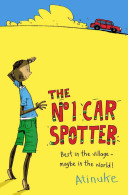
The No. 1 Car Spotter
Written by Atinuke
Walker, 2010, 112 pp.
ISBN: 978-1406320770
A great deal of children’s and adolescent literature about Africa is being published, but most of it falls into two categories: books that tell myths, folktales and fables representing traditional stories and more recently, books recounting stories from violent, war torn villages and refugees.
Nigerian storyteller Atinuke offers a different narrative about Africa in her charming novel The Number One Car Spotter. Like her Anna Hibiscus books, this early reader chapter book is set in contemporary Africa. The novel centers on Oluwalase Babatunde Benson, a boy who lives in a small African village between the forest, the river, and the main road into the city. Everyone calls him No. 1 because he can spot and identify cars coming toward the village before anyone else. While the men of the village celebrate No. 1’s ability to spot cars, the women of the village feel spotting cars does not have much value, so he is put to work collecting firewood, hoeing fields, and herding the cows and goats. No. 1’s father works in the city and sends money home. No. 1 is clever and a problem solver who comes up with inventive solutions to problems that arise in the village, like turning an old Toyota Corolla into a wagon so villagers can take their produce to the market, providing his Auntie Fine-Fine with a beauty makeover, and helping his sickly grandmother get the medicine she needs.
This book has much to offer its readers, including endearing characters, interesting plot lines, and accessible text in the form of a chapter book with sketches that animate the characters and events for the reader. Additionally, embedded in the novel is cultural, social, and geographical information and opportunities to experience present-day children living in Africa. However, one of the most inviting features of the novel is the rich and culturally specific language. The following excerpt is an example of Atinuke’s keen ear for language,
There are some few people in our village.
My best friend, Coca-Cola, lives in one compound with his old grandmother, newborn sisters, Sunshine and Smile, and his mother, Mama Coca-Cola.
My sister’s best friend, Nike, lives in another compound with her elder brothers, Emergency and Tuesday, and her father, Uncle Go-Easy.
Beke, Bisi and Bola, the small children, live with their mother, Mama-B, and Auntie Fine-Fine.
There are other people in other compounds, but these are the people who know me well. (p. 9)
Atinuke is a professional storyteller. Although she now resides in Wales, she grew up in Nigeria and in Great Britain. Through her writing she seeks to share the Africa of her childhood. Further information about Atinuke and about her reasons for writing about “generic Africa” can be found in the review of Anna Habiscus in this issue of WOW Review.
No. 1 Car Spotteris a book that can potentially invite explorations of family, social and economic systems, and critical inquiries into literature about Africa. The novel alludes to the hardships of living in a poor village, but the stories focus on everyday victories, humor, and artful representations of the characters’ daily way of life. Other books that would pair nicely with No. 1 Car Spotter are Goal! (2010) by Mina Javaherbin and illustrated by A.G. Ford and Beatrice’s Goat (2004) by Page McBrier and Loni Lohstoetor. Set in a dry South African township, Goal! is about a boy named Ajani, who wins a brand new soccer ball and plays an “epic” game with his friends on the dusty streets. Beatrice’s Goat, set in Uganda, is about a young girl living in poverty whose life is changed when the gift of a goat significantly impacts the economic challenges of the family and she able to fulfill her dream of going to school.
Tracy Smiles, Western Oregon University, Monmouth, OR
WOW Review, Volume IV, Issue 4 by Worlds of Words is licensed under a Creative Commons Attribution-NonCommercial-ShareAlike 4.0 International License. Based on work at https://wowlit.org/on-line-publications/review/iv-4/
